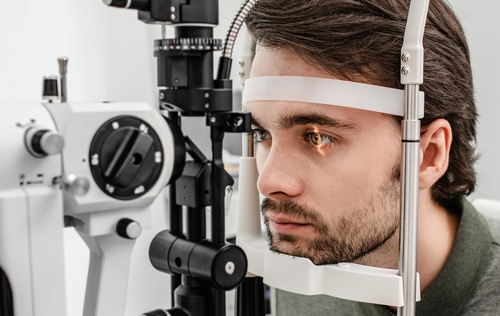
Being about proactive about your vision starts with getting your eyes checked regularly. Many sight-threatening eye conditions usually have no symptoms in the early stages.
Fortunately, many of these eye conditions can be caught through routine eye exams and treated promptly, preventing further damage to your vision. Keep reading to learn more about how often you should have eye exams and what to expect during a comprehensive eye examination!
When to Get an Eye Exam
The American Academy of Ophthalmology provides general guidelines for regular vision screenings for kids and routine eye exams for adults.
Newborns
A doctor or other trained medical professional should examine your newborn’s eyes shortly after birth. They may test your child’s eyes for blinking and pupil response.
They may also look for a red reflex. Ideally, a bright light shining on each eye should return a red reflex. If it doesn’t, further tests could be necessary.
You may be referred to a pediatric ophthalmologist for a comprehensive eye examination if your baby:
- Has signs of eye disease
- Is born prematurely
- Has a family history of childhood eye disease
Six to Twelve Months
Your baby’s second screening should be between six and twelve months at their well-child exam. In addition to the tests done above, the pediatrician will also check that your baby has healthy eye movement and alignment.
They will also want to ensure that your baby’s eyes are healthy and are developing properly.
One to Three Years
Your child’s pediatrician should check for healthy eye development at ages one to three. A photoscreening test may also be performed to help diagnose eye conditions like lazy eye.
If there’s a problem, you’ll be referred to a pediatric ophthalmologist.
Three to Five Years
Between ages three and five, the following should be checked by a pediatrician, family physician, optometrist, or ophthalmologist:
- Eye and vision alignment
- The sharpness of vision, once your child can read an eye chart
- Photoscreening to test for lazy eye, misaligned eyes, refractive errors, and other focusing problems
If any vision problem is detected, treatment should be started without delay to safeguard your child’s vision.
Five Years and Above
Once your child is age five, they should be screened for visual alignment and acuity. A common vision problem in this age group is nearsightedness, which is often easily corrected with prescription glasses.
Adults
If your vision is tip-top and your eyes healthy, you should have a comprehensive eye exam once in your twenties and twice in your thirties. After this, your next complete eye exam should be at age forty.
That’s when changes in your vision and early symptoms can start to appear. Remember, prompt diagnosis and timely treatment are critical to preserving your vision.
There are exceptions to these guidelines. If you have eye pain, an infection, or notice sudden flashes and floaters, don’t wait until your next visit. Contact your ophthalmologist.
Annual visits to your eye doctor are recommended if you wear contact lenses. If you have high blood pressure, a previous eye injury or surgery, diabetes, or a family history of certain eye health problems like glaucoma, your ophthalmologist will recommend more frequent eye exams.
Ensure you follow the schedule provided by your eye doctor, particularly as you grow older. You’re at higher risk for eye diseases as you age.
Seniors
If you’re sixty-five years and older, it’s best to get eye exams every one to two years. Your eye doctor will look for signs of age-related eye conditions like:
- Diabetic retinopathy
- Cataracts
- Age-related macular degeneration
- Glaucoma
Can you remember the last time you had your eyes checked? If not, now is a perfect time. Schedule your routine eye examination at Morganton Eye and Surgery Center in Morganton, NC, today to ensure you enjoy a lifetime of good vision!
